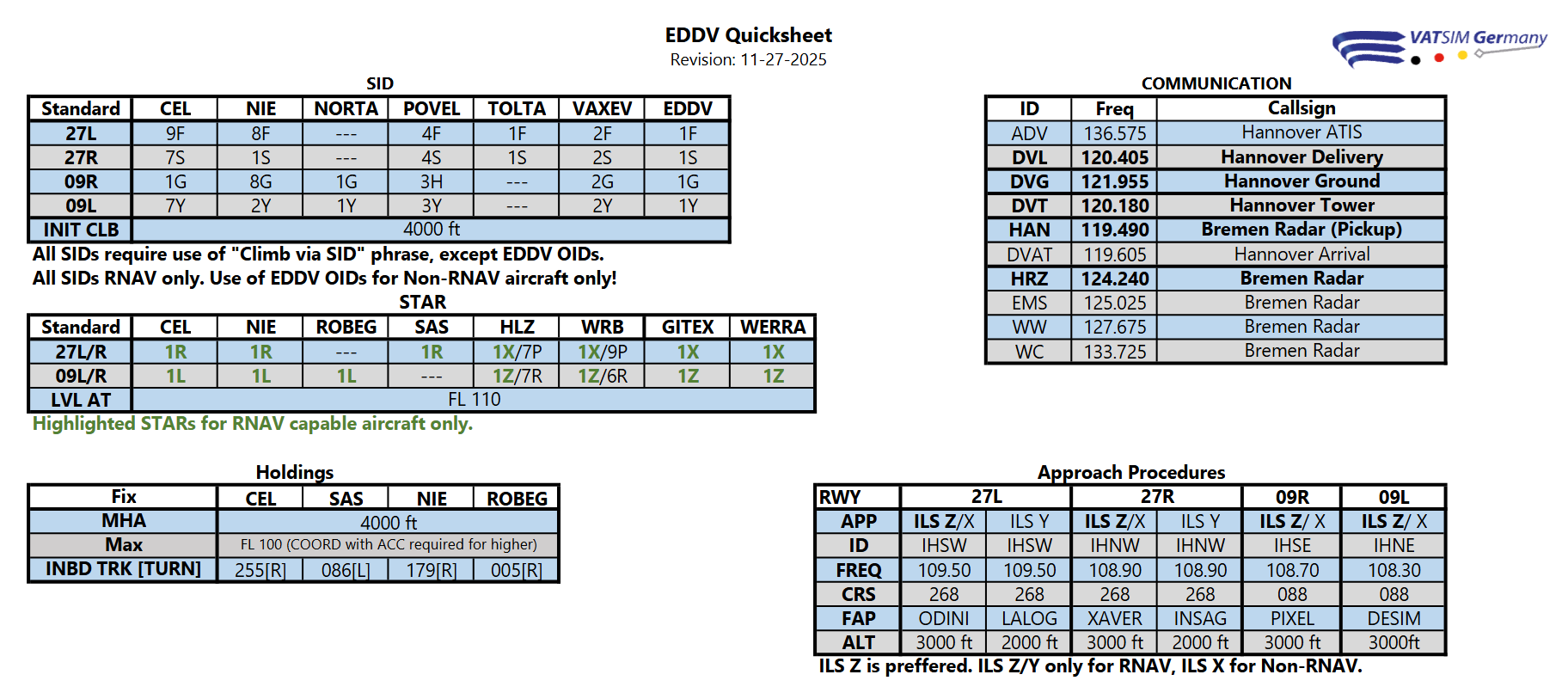Delivery
Initial climb clearance: The initial climb clearance at Hanover is 4000ft on all published departure procedures. The altitude shall be entered as cleared altitude (CFL) in an appropriate list or tag.
PDC: The use of PDC (Pre Departure Clearance) is permitted in Hannover, but not mandatory. The code "EDDV" shall be used. Pilots are advised to enter the requested departure runway in the Optional Free Text field of the DCL dialogue.
When using startup times, keep in mind not giving “startup approved” in the PDC clearance.
SIDs
NORTA/TOLTA SIDs
Traffic to the south will depart either via TOLTA or NORTA. NORTA SIDs are only available from RWYs 09R and 09L, whereas TOLTA is only available out of RWYs 27R and 27L. With that, cases exist where Hannover Delivery needs to issue a re-clearance to the pilot:
| Departure RWY | Filed Flight Plan via | Re-clearance via | Alias Command |
| 27R or 27L |
NORTA P605 ELNAT | TOLTA DCT WERRA flight planned route. | .rctolta-werra |
| NORTA P12 WRB | TOLTA DCT WRB flight planned route. | .rctolta-wrb | |
| 09R or 09L | TOLTA | NORTA DCT TOLTA flight-planned route | .rcnorta |
The vSID will automatically choose the correct SID per runway, but will highlight any SID where a re-clearance is required (purple colour). In this case, Hannover Delivery shall issue the re-clearance and amend the flight plan accordingly.
OIDs
As all SIDs out of Hanover are for RNAV-capable aircraft only, certain contingency procedures for non-RNAV aircraft need to be applied. For non-RNAV aircraft intending to depart IFR out of EDDV, so-called Omnidirectional Instrument Departures (OIDs) will be used instead.
These OIDs will guide the departing aircraft on runway heading until reaching 2400 ft. Thereafter, the departing traffic will continue as cleared by ATC. Further information is available here: https://knowledgebase.vatsim-germany.org/link/1167#bkmrk-omnidirectional-inst
The further clearance is subject to the clearance coordinated with Bremen Radar.
All EDDV OIDs shall be coordinated with Bremen Radar (sector HAN) before IFR clearance is issued.
Runway Assignment
The departure runway mainly depends on the aircraft type and the pilots preference.
- Heavy aircraft (e.g. A332, B748, B763) shall depart from runway 09L/27R
- avoid crossing departures: northbound departures should depart from 09L/27R
- RWY Config 09: VAXEV departures should depart from runway 09L
Delivery is responsible for an appropriate runway assignment, so each runway has an equal workload.
Low Visibility Operations (LVO)
At Hannover, the following runway configuration is to be used during LVO:
- Departures 09R/27L*, Arrivals 09L/27R
Departures may request runway 09L/27R for performance reasons. In this case, a larger arrival spacing shall be by Tower requested to accommodate the departing traffic in between.
* Note: Runway 09R/27L can only used for departing traffic if the RVR is not less than 350 m. If the RVR is below 350 m, runway 09L/27R shall be the only runway in use for both departing and arriving traffic.
Delays and Startup
Delay of traffic: In high traffic situations, it may be necessary for departing traffic to be held back. In addition, Delivery shall make arrangements to comply with restrictions imposed by other airports through notice on the ECFMP Discord, coordination, etc.
Startup: A startup shall be granted if no major traffic delays are expected. When allocating startups linked to times, the airport specific rate of 40 departures per hour can be used as a basis.
Specials
Vectored and visual departures: The use of vectored or visual departures requires prior coordination with the responsible radar station. An initial altitude to climb shall be provided.
IFR local flights: IFR local flights are coordinated with the responsible radar controller, who may instruct a different departure procedure, possibly vectored departures.
vSID Plugin Commands
The following plugin commands for vSID are available at EDDV:
| Command |
Explanation |
|
.vsid rule eddv low (disabled by default) |
When enabled, runway 09R/27L will be preferred for all medium and light aircraft (disregarding the standard runway assignment). |
|
.vsid area eddv gat |
This will clear all aircraft at the GA-Aprons according to the standard runway assignment (09L/27R will not be preferred anymore). |
Coordinator Delivery
Times of use: A Coordinator Delivery can be staffed when all other Ground stations are manned. The position shows its potential, especially during events.
Role and function: The Delivery Coordinator supervises the traffic flow at and in the vicinity of the aerodrome. His duties include:
- observing airport and surrounding and detect lacks of efficiency
- managing departure list, including SID assignment, flightplan check and squawk assignment
- Slot management (if needed)
- service for text pilots
- PDC service
- when controllers are busy coordination with adjacent stations
The main Delivery is responsible for all requests via voice on frequency.
For these duties, it is recommended to use some tools which are not included in the vanilla version of EuroScope. TopSky (included in the DFS_Pack) offers windows showing the current and predicted operations rate of specific airports or a specific sector.
Measures:
- MDI (minimum departure interval) for specific SIDs to relieve sectors and airports
- delays, e.g. for pushback clearance to prevent overload at holding points
- observing for potential conflicts at the ground
- checking tools for inbounds and coordinating MDIs or MIT (miles in trail) in consultation with radar stations
Always make the right level of restrictions. A restriction shall not lead to over- or underload of the airport and its controllers. Keep in mind, a measure only shows its effect after a certain time.

